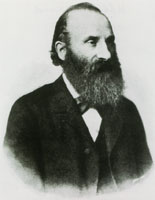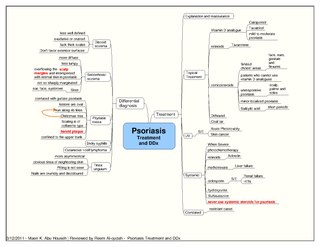Related Research Articles

Psoriasis is a long-lasting, noncontagious autoimmune disease characterized by raised areas of abnormal skin. These areas are red, or purple on some people with darker skin, dry, itchy, and scaly. Psoriasis varies in severity from small, localized patches to complete body coverage. Injury to the skin can trigger psoriatic skin changes at that spot, which is known as the Koebner phenomenon.

Hidradenitis suppurativa (HS), sometimes known as acne inversa or Verneuil's disease, is a long-term dermatological condition characterized by the occurrence of inflamed and swollen lumps. These are typically painful and break open, releasing fluid or pus. The areas most commonly affected are the underarms, under the breasts, and the groin. Scar tissue remains after healing. HS may significantly limit many everyday activities, for instance, walking, hugging, moving, and sitting down. Sitting disability may occur in patients with lesions in sacral, gluteal, perineal, femoral, groin or genital regions; and prolonged periods of sitting down itself can also worsen the condition of the skin of these patients.

Psoriatic arthritis is a long-term inflammatory arthritis that occurs in people affected by the autoimmune disease psoriasis. The classic feature of psoriatic arthritis is swelling of entire fingers and toes with a sausage-like appearance. This often happens in association with changes to the nails such as small depressions in the nail (pitting), thickening of the nails, and detachment of the nail from the nailbed. Skin changes consistent with psoriasis frequently occur before the onset of psoriatic arthritis but psoriatic arthritis can precede the rash in 15% of affected individuals. It is classified as a type of seronegative spondyloarthropathy.
Alefacept is a genetically engineered immunosuppressive drug. It was sold under the brand name Amevive in Canada, the United States, Israel, Switzerland and Australia. In 2011, the manufacturers made a decision to cease promotion, manufacturing, distribution and sales of Amevive during a supply disruption. According to Astellas Pharma US, Inc., the decision to cease Amevive sales was neither the result of any specific safety concern nor the result of any FDA-mandated or voluntary product recall. On the other hand, usage of Amevive was associated with a certain risk of development systemic diseases such as malignancies. This drug was never approved for the European drug market.

The National Psoriasis Foundation (NPF) is the world's largest nonprofit organization serving people with psoriasis and psoriatic arthritis. The NPF provides information and services to help people manage their condition while supporting research to find a cure. In addition to serving more than 3 million people annually through patient and professional health education and advocacy initiatives, the NPF has funded more than $10 million in psoriatic disease research grants and fellowships.

Heinrich Koebner ; was a German-Jewish dermatologist born in Breslau.
In medicine, a finger tip unit (FTU) is defined as the amount of ointment, cream or other semi-solid dosage form expressed from a tube with a 5 mm diameter nozzle, applied from the distal skin-crease to the tip of the index finger of an adult. The "distal skin-crease" is the skin crease over the joint nearest the end of the finger. One FTU is enough to treat an area of skin twice the size of the flat of an adult's hand with the fingers together, i.e. a "handprint". Two FTUs are approximately equivalent to 1 g of topical steroid.

Psoriatic onychodystrophy or psoriatic nails is a nail disease. It is common in those with psoriasis, with reported incidences varying from 10% to 78%. Elderly patients and those with psoriatic arthritis are more likely to have psoriatic nails.

Psoriatic erythroderma represents a form of psoriasis that affects all body sites, including the face, hands, feet, nails, trunk, and extremities. This specific form of psoriasis affects 3 percent of persons diagnosed with psoriasis. First-line treatments for psoriatic erythroderma include immunosuppressive medications such as methotrexate, acitretin, or ciclosporin.
Generalized pustular psoriasis (GPP) is an extremely rare type of psoriasis that can present in a variety of forms. Unlike the most general and common forms of psoriasis, GPP usually covers the entire body and with pus-filled blisters rather than plaques. GPP can present at any age, but is rarer in young children. It can appear with or without previous psoriasis conditions or history, and can reoccur in periodic episodes.
Briakinumab (ABT-874) is a human monoclonal antibody being developed by Abbott Laboratories for the treatment of rheumatoid arthritis, inflammatory bowel disease, and multiple sclerosis. As of 2011 drug development for psoriasis has been discontinued in the U.S. and Europe.
Ixekizumab, sold under the brand name Taltz, is an injectable medication for the treatment of autoimmune diseases. Chemically, it is a form of a humanized monoclonal antibody. The substance acts by binding interleukin 17A and neutralizing it, reducing inflammation.
Guselkumab, sold under the brand name Tremfya, is a monoclonal antibody against interleukin-23 used for the treatment of plaque psoriasis.
Stasis papillomatosis is a disease characterized by chronic congestion of the extremities, with blood circulation interrupted in a specific area of the body. A consequence of this congestion and inflammation is long-term lymphatic obstruction. It is also typically characterized by the appearance of numerous papules. Injuries can range from small to large plates composed of brown or pink, smooth or hyperkeratotic papules. The most typical areas where injuries occur are the back of the feet, the toes, the legs, and the area around a venous ulcer formed in the extremities, although the latter is the rarest of all. These injuries include pachydermia, lymphedema, lymphomastic verrucosis and elephantosis verrucosa. The disease can be either localized or generalized; the localized form makes up 78% of cases. Treatment includes surgical and pharmaceutical intervention; indications for partial removal include advanced fibrotic lymphedema and elephantiasis. Despite the existence of these treatments, chronic venous edema, which is a derivation of stasis papillomatosis, is only partially reversible. The skin is also affected and its partial removal may mean that the skin and the subcutaneous tissue are excised. A side effect of the procedure is the destruction of existing cutaneous lymphatic vessels. It also risks papillomatosis, skin necrosis and edema exacerbation.
The Psoriasis Index of Quality of Life (PSORIQoL) is a patient-reported outcome measure which determines the quality of life of patients with psoriasis. It is based on a needs-based approach to quality of life.

Ponesimod, sold under the brand name Ponvory, is a medication for the treatment of multiple sclerosis (MS).
The Eczema Area and Severity Index (EASI) is a tool for the measurement of severity of atopic dermatitis. It ranges from 0 to 72.

Calcipotriol/betamethasone dipropionate, sold under the brand name Taclonex among others, is a fixed-dose combination medication of the synthetic vitamin D3 analog calcipotriol (also known as calcipotriene) and the synthetic corticosteroid betamethasone dipropionate for the treatment of plaque psoriasis. It is used in the form of ointment, topical suspension, gel, aerosol, and foam.
The Dermatology life Quality Index (DLQI) is a ten-question questionnaire used to measure the impact of skin disease on the quality of life of an affected person. It is designed for people aged 16 years and above.
Risankizumab, sold under the brand name Skyrizi, is a humanized monoclonal antibody targeting interleukin 23A (IL-23A). Risankizumab is part of a collaboration between Boehringer Ingelheim and AbbVie. Risankizumab has been approved in the European Union, the United States, and Canada for the treatment of moderate to severe plaque psoriasis in adults who are candidates for systemic therapy, and moderate to severe Crohn's disease in the United States. In Japan, it is approved for treating plaque psoriasis, generalized pustular psoriasis, erythrodermic psoriasis and psoriatic arthritis in adults who have an inadequate response to conventional therapies.
References
- ↑ "Psoriasis Update -Skin & Aging" . Retrieved 2007-07-28.
- ↑ "Is PASI 90 becoming the new PASI 75?". Practice Update. Retrieved 2015-02-26.
- ↑ KREFT, Samo, KREFT, Marko, RESMAN, Aleksander, MARKO, Pij B., ZAJC-KREFT, Katarina. Computer-aided measurement of psoriatic lesion area in a multicenter clinical trial - Comparison to physician's estimations. J. dermatol. sci. (Amst.), 2006;44(1):21-7.
- ↑ Louden BA, Pearce DJ, Lang W, Feldman SR (2004). "A Simplified Psoriasis Area Severity Index (SPASI) for rating psoriasis severity in clinic patients". Dermatol. Online J. 10 (2): 7. doi:10.5070/D318W9J736. PMID 15530297.
- ↑ Langley RG, Ellis CN: Evaluating psoriasis with Psoriasis Area and Severity Index, Psoriasis Global Assessment, and Lattice System Physician’s Global Assessment. J Am Acad Dermatol 2004;51:563-9.